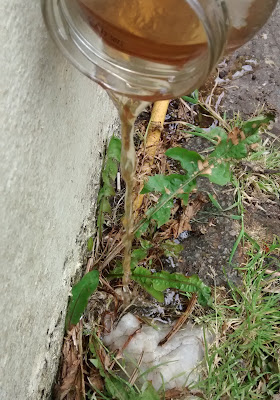Pouring the leftover pickle vinegar onto a dandelion
I get through a lot of pickles, onions and gherkins mainly.
I’m sure you are not really interested in my supper routine but I do find them
very palatable with a bit of cheese.
The Americans seem to love pickles too if
the raised bed Facebook page is anything to go by. Nearly every other post is someone taking
pictures of their ‘canning’ harvest and cucumbers seem to be top of the
list. I have pickled my own onions and
beetroot in the past and probably will do again, but I’ll need to set a field
aside for the amount I get through. I find the vinegar really settles the
stomach and medicinal, curing anything from sunburn to hiccups. It’s not much
of a breath freshener though and I do see people backing away from me when I’m
talking sometimes, but maybe that’s more to do with what I’m saying rather than
what I am spraying if you get me.
Natural Weedkiller
There are also a lot of posts on the Facebook page about how
vinegar makes a great weed killer. It’s claimed to be as effective as the harsh
polluting chemicals we get from the multinationals. The recipe is nearly always
a subtle modification of: ½ gallon of
vinegar, ½ cup of salt and 2 tablespoons of washing up liquid. I hasten to
point out that all of these items are still chemicals, even though we use them so
often we forget. Vinegar contains acetic acid, salt is sodium chloride and
washing up liquid is made in an industrial process, this is used to spread out
the water droplets when it’s applied to the plants. It’s more commonly known as
a “surfactant”
I thought it was about time I did my own research and do
some tests myself, so over the last year or so I have been trying it out on my
own garden and taking into account the fact these are still chemicals I have
been careful where I pour it.
My driveway has a lot of cracks in it so the solution was
poured into the areas where perennial and annual weeds were growing. The
combination of the acetic acid, salt, and soap eventually killed many annual
weeds, especially when applied to small weeds, but the perennials just kept
coming back.
The vinegar - salt solution works on contact primarily by
disrupting the cell walls of the leaves. It will not travel long distances
through the plant (say, from one leaf to another). So if you don’t get complete
coverage of the plant leaves with the vinegar and salt solution, there is
potential for the plant to re-grow from the living tissues. The vinegar- salt
solution, since it doesn’t move throughout the plant, will not be effective on
perennial weeds. It will burn off the top growth of perennials (which may be
desirable), but it will not provide long-term control.
The contact nature of the vinegar and soap can be a benefit,
though. If you need to kill weeds in close proximity to a desirable plant for
example. But you will need to miss out
the salt or you will poison the soil and it could run off into the waterways.
I have also been emptying the salt free contents of my
amassed vinegar bottles directly onto weeds again with mixed results. Some
annual weeds have withered but the perennial dandelions have just got mottled
leaves and are still growing well. I also have small heaps of red pepper bits
and dill leaves collecting in corners where they came out of the gherkin jars.
Industrial
For vinegar to be really effective we would need industrial
strength. Shop bought vinegar is about 2-5% acetic acid and for a weedkiller,
it’d need to be about 20% acid. If that were the case we would have to adorn
rubber gloves, facemasks and protective clothing and not the pinny I usually
wear.
So all in all, vinegar does do a bit on the garden, but I’d
be tempted to apply it without the salt as it’ll poison the ground and wash
into the waterways and soap… so it’s straight out of the jars from now on.
Another idea
As things are being throw into the garden from the kitchen,
how about pouring the cooking water from vegetables onto the plants (after it’s
cooled of course) again, it’d need to be a solution with no salt added.
Vitamins and minerals lost from cooking the vegetables are
released in the water. Even boiled egg
water leaves behind calcium, so use the liquid to water calcium-loving
solanaceous garden plants: tomatoes, potatoes, aubergine, peppers, and squash.
Even pasta and potato starch water will spur the release of
plant nutrients in the soil, meaning starch may be better for plants than for
us.
